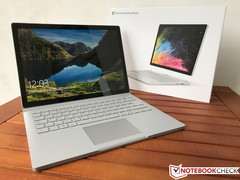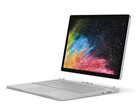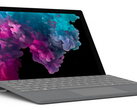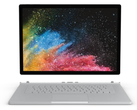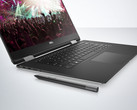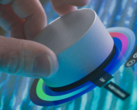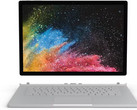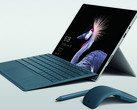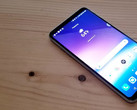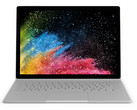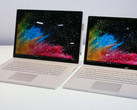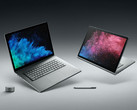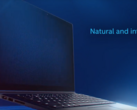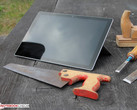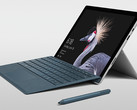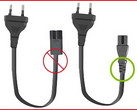When Microsoft unveiled the Surface Book 2 in October, the press was enamored by its sleek looks and multi-mode features that appeared to check all the right boxes over the original 2015 Surface Book. From our point of view, however, we had immediate reservations about how Microsoft was able to cram a non-Max-Q GTX 1050 and GTX 1060 into such a thin form factor detachable to begin with without some behind-the-scenes drawbacks.
Now that systems are finally shipping to consumers, we've had a chance to play around with our own 13.5-inch unit and have been documenting our findings on our preview page here. As it turns out, Microsoft had to cut some deep corners in order to fit all that power under the hood.
First, our initial CPU stress tests confirm that the quad-core i7-8650U CPU throttles heavily following just a single run of CineBench R15 Multi-Thread as shown by our graph below. The Kaby Lake-R processor scores a respectable 675 points on its initial run only to nosedive to 503 points by the fourth loop to represent a performance drop of just over 25 percent. For comparison's sake, the dual-core i5-7300HQ commonly found on most entry-level gaming notebooks is just slightly faster with an average score of 515 points despite having half the parallel threads as the i7-8650U. Perhaps unsurprisingly, we noted similar behavior on the recent Surface Pro 5 i7-7660U tablet as well.
Making matters worse for Microsoft, power consumption tests as performed by PC World reveal that the 15-inch Surface Book 2 GTX 1060 SKU will consume battery power faster than it can recharge. In other words, be prepared to see your battery percentage reading slowly tick away from 100 percent to 85 percent or lower over time when running consistently heavy loads and when properly connected to an outlet. The source blames the insufficient 102 W AC adapter as most gaming notebooks with the same GTX 1060 GPU typically ship with more capable 150+ W adapters to avoid such issues. The system will not drain its battery until 0, however, as PC World notes that the GTX 1060 GPU will eventually throttle all the way down to 1 GHz to prevent draining the battery any further. We will run similar tests on the 13.5-inch GTX 1050 unit and reconfirm the oddball power consumption behavior on our eventual 15-inch GTX 1060 review.
Lastly, it's worth noting that the 13.5-inch Surface Book 2 utilizes the exact same Panasonic MEI96A2 3:2 IPS panel as does the first generation Surface Book and should share very similar black-white and gray-gray response times. We've yet to record the final values for the Surface Book 2 as our table below shows and we will update the numbers once we've double-checked the readings. Based on the first generation Surface Book, however, its black-to-white response time of 21 ms is slower than on Microsoft's latest Surface Pro tablet (18 ms) and much slower than on the Gigabyte Aero 14 (13.2 ms) or MSI GS63VR (4.4 ms). While the heavy ghosting isn't much of an issue on the original Surface Book because of its limited graphics capabilities, anyone expecting to game on the more capable 15-inch Surface Book 2 GTX 1060 may find the slow response times distracting for fast-moving 3D games.
| Microsoft Surface Book 2 Panasonic MEI96A2 , , 3000x2000, 13.5" | Microsoft Surface Book with Performance Base Panasonic MEI96A2, , 3000x2000, 13.5" | Microsoft Surface Pro (2017) m3 LG Display LP123WQ112604, , 2736x1826, 12.3" | MSI GS63VR 7RG-005 Chi Mei N156HHE-GA1 (CMN15F4), , 1920x1080, 15.6" | Gigabyte Aero 14-K7 LG Philips LP140QH1-SPF1 (LGD049A), , 2560x1440, 14" | |
|---|---|---|---|---|---|
| Display | |||||
| Display P3 Coverage (%) | 67.9 | 66.4 | 68.5 | 91.6 | 65.1 |
| sRGB Coverage (%) | 95.7 | 95.4 | 99.2 | 100 | 91.2 |
| AdobeRGB 1998 Coverage (%) | 69.4 | 67.6 | 70.1 | 86.6 | 65.9 |
| Response Times | |||||
| Response Time Grey 50% / Grey 80% * (ms) | 52.8 ? | 61 ? | 42 ? | 10.4 ? | 40 ? |
| Response Time Black / White * (ms) | 30 ? | 37 ? | 28 ? | 6.6 ? | 25.2 ? |
| PWM Frequency (Hz) | 25510 ? | 130 ? | |||
| Screen | |||||
| Brightness middle (cd/m²) | 385 | 459 | 461 | 269 | 277 |
| Brightness (cd/m²) | 372 | 423 | 444 | 254 | 252 |
| Brightness Distribution (%) | 89 | 86 | 93 | 85 | 84 |
| Black Level * (cd/m²) | 0.21 | 0.37 | 0.34 | 0.21 | 0.27 |
| Contrast (:1) | 1833 | 1241 | 1356 | 1281 | 1026 |
| Colorchecker dE 2000 * | 1.6 | 2.28 | 3.43 | 3 | 4.26 |
| Colorchecker dE 2000 max. * | 4.5 | 3.61 | 5.55 | 5.62 | 8.37 |
| Greyscale dE 2000 * | 1.5 | 2.48 | 3.08 | 3.18 | 4.32 |
| Gamma | 2.22 99% | 2.5 88% | 3.03 73% | 2.25 98% | 2.37 93% |
| CCT | 6502 100% | 8602 76% | 7014 93% | 7274 89% | 7298 89% |
| Color Space (Percent of AdobeRGB 1998) (%) | 64 | 62 | 64 | 77 | 59 |
| Color Space (Percent of sRGB) (%) | 95.9 | 96 | 99 | 100 | 91 |
| Total Average (Program / Settings) |
* ... smaller is better
We're only halfway through our usual measurements and these numbers may be adjusted over time, but the preliminary data do not paint a good picture for gamers. Fortunately, Microsoft is not advertising the 13.5-inch or 15-inch Surface Book 2 as gaming machines even though they house GPUs found on $1000 gaming notebooks. A small subset of demanding professional graphic artists, however, may still lament the fact that CPU performance, GPU performance, and display response times have all been deliberately neutered in one way or another seemingly for the purposes of a thinner and more visually unique product.
We've reached out to Microsoft for official comments on our CPU throttling findings and will update the post when appropriate.
Expect our full review on the 13.5-inch Surface Book 2 by the following week.




